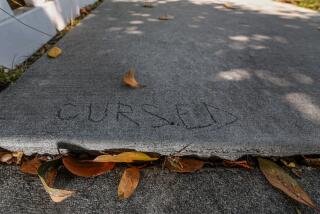L.A. streets aren’t safe enough for cyclists, but we’re getting there
As The Times’ Paul Whitefield points out in his Oct. 24 post saying there’s little hope for making L.A.’s streets safer for cylists, there’s Hollywood, and there’s real life. And in real-life Los Angeles County, nearly 1 in 4 trips does not involve an automobile.
How can this be in our notoriously car-addled city? Angelenos are looking for options and finding them in our burgeoning Metro system, our sometimes-broken sidewalks and, yes, our expanding bike network. Since adopting its Bicycle Plan in 2011, the city of Los Angeles has doubled its bike lane miles and been recognized as a Bronze-level Bicycle Friendly Community for this and other accomplishments.
ABOUT BLOWBACK: FAQs and submission policy
Anecdotal evidence aside, Whitefield is right that Los Angeles is not yet safe enough for people getting around under their own power, whether on two wheels or two feet. Although 19% of trips in the county are on foot or on bike, 39% of our roadway fatalities are people walking and biking.
L.A.’s streets are by and large not designed with the safety of our most vulnerable travelers in mind. We still use car-centric design standards instead of those common in urban areas with better safety records. L.A. is only beginning to experiment with advanced bike facilities routinely found in New York, Chicago and elsewhere. We spend only 1% of transportation dollars on walking and biking combined, far disproportionate to the percentage of trips made by cyclists and pedestrians. There is clearly much work to do.
Advocacy groups such as the Los Angeles County Bicycle Coalition, Los Angeles Walks and the Safe Routes to School National Partnership are making progress in the nation’s car capital. As a City Council member, Eric Garcetti was responsible for hiring L.A.’s first pedestrian coordinators, who are now hard at work striping high-visibility crosswalks, installing pedestrian plazas and parklets, and prioritizing safety projects as part of the Safe Routes to School Strategic Plan. Mayor Garcetti’s newly announced Great Streets Initiative promises to transform L.A.’s iconic boulevards into destinations rather than just thoroughfares.
FULL COVERAGE: Sharing the road in L.A.
Meanwhile, the Bicycle Coalition’s Active Streets L.A. program is engaging communities around making neighborhood streets safe and pleasant places to walk and bike.
L.A. County’s leaders have an opportunity to build on this incredible momentum by investing in safer streets. All these plans, initiatives and programs are only as valuable as the funding dedicated to implementing them. Garcetti’s transportation vision will depend on his ability to work with Metro to prioritize investments in walking and biking.
L.A.’s streets are not yet safe enough, but we don’t need to throw up our hands in despair. Just as we can rebuild the rail system we were all too eager to abandon, we can modernize our streets to serve all who use them. One-day events like CicLAvia demonstrate Angelenos’ incredible hunger for safe places to walk and bike.
Instead of debating who gets the short end of the stick when trying to share streets designed in the 1960s, we should all be demanding streets that reflect the way we want to get around in this century.
ALSO:
McManus: A plague on both your parties
Should a liar be a lawyer? The Stephen Glass case.
Obamacare insurance cancellations: Readers aren’t buying it
Jennifer Klausner is the executive director of the Los Angeles County Bicycle Coalition.
This post is part of an ongoing conversation to explore how the city’s cyclists, drivers and pedestrians share and compete for road space, and to consider policy choices that keep people safe and traffic flowing. For more: latimes.com/roadshare and #roadshareLA.
More to Read
A cure for the common opinion
Get thought-provoking perspectives with our weekly newsletter.
You may occasionally receive promotional content from the Los Angeles Times.










